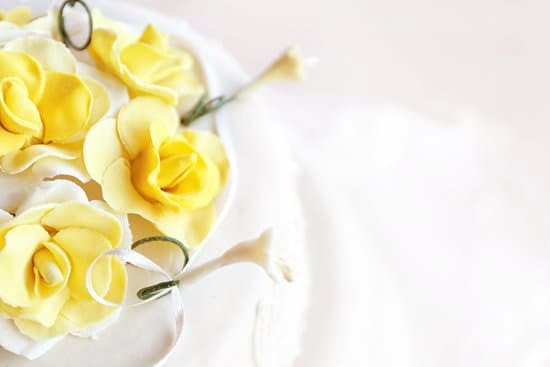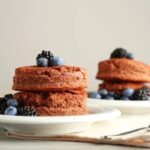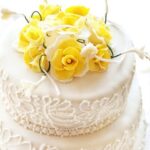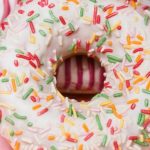Cake decorating tubes are an essential tool for any baker looking to elevate their cake creations to new heights. These small, cylindrical pipes allow you to create beautiful designs and intricate details with ease. From simple lines and swirls to intricate flowers and patterns, the possibilities are endless when it comes to cake decorating tubes.
In this article, we will delve into the exciting world of cake decorating tubes, exploring the different types and materials available. Understanding the basics of these tubes is crucial for any aspiring baker or seasoned professional. By knowing the differences between various tubes, you can choose the best ones for your specific needs and designs.
For beginners, we will also provide a comprehensive review of the top five cake decorating tubes. Whether you’re new to cake decorating or just want to try out some new techniques, these tubes are perfect for honing your skills and creating stunning cakes. We will cover their features, pros and cons, and offer tips on how to use them effectively.
So get ready to unleash your creativity as we guide you through the thrilling world of cake decorating tubes. With our expert advice and techniques, you’ll be able to take your cakes from ordinary to extraordinary in no time. So let’s dive in and discover all that cake decorating tubes have to offer.
The Basics of Cake Decorating Tubes
Cake decorating tubes are essential tools for creating beautiful and intricate designs on cakes. They come in a variety of types and materials, each with its own unique features and benefits. Understanding the different options available will help you choose the best cake decorating tube for your needs.
One of the most common types of cake decorating tubes is the round tip. These are versatile and can be used for everything from writing to outlining shapes and creating borders. They are available in various sizes, allowing for different levels of precision in your designs.
Another popular type is the star tip, which produces a ridged or textured effect when piping. These tips are often used to create floral designs, rosettes, or piped stars on top of cakes or cupcakes. The size and shape of the star tip will determine the size and style of the design you can achieve.
There are also specialty tips available, such as leaf tips, petal tips, and basketweave tips. Leaf tips are shaped like a narrow tear drop and are used to create realistic leaves or foliage on cakes. Petal tips have a curved shape that allows for easy creation of flowers petals. Basketweave tips have a zigzag pattern that creates an intricate woven effect resembling a basket.
When it comes to materials, cake decorating tubes can be made from either metal or plastic. Metal tubes are known for their durability and precision but require careful maintenance to prevent rusting. Plastic tubes, on the other hand, are more affordable and easier to clean but may not provide the same level of control as metal ones.
Understanding these basics will help you choose the right cake decorating tube for your desired designs. Whether you’re just starting out or looking to expand your collection, experimenting with different types and materials will allow you to unleash your creativity in cake decorating.
| Cake Decorating Tube Type | Common Uses |
|---|---|
| Round tip | Writing, outlining shapes, creating borders |
| Star tip | Creating floral designs, rosettes, piped stars |
| Leaf tip | Creating realistic leaves or foliage |
| Petal tip | Creating flower petals |
| Basketweave tip | Creating woven basket effect |
Exploring the Top 5 Cake Decorating Tubes for Beginners
Cake decorating tubes are an essential tool for anyone who wants to take their cake decorating skills to the next level. With so many options available, it can be overwhelming to choose the right tube for your needs. In this section, we will explore the top 5 cake decorating tubes that are perfect for beginners.
- Round Tip: The round tip is a versatile option that is great for creating dots, writing messages, and outlining designs on cakes. It is perfect for beginners as it allows for easy control and precision. This tip comes in different sizes, which allows for variation in design.
- Star Tip: The star tip adds a touch of elegance and texture to cakes. It is commonly used to create rosettes, stars, shells, and other decorative patterns. This tip is easy to use and produces beautiful results even for those who are new to cake decorating.
- Leaf Tip: If you want to add a botanical touch to your cakes, the leaf tip is a must-have. It creates lifelike leaves that can be used as accents or as part of intricate floral designs. Its shape mimics the natural contours of leaves, making it easy to achieve a realistic appearance.
- Petal Tip: As its name suggests, the petal tip is ideal for creating delicate petals on flowers and other floral details. This tip gives cakes an elegant and feminine look and is perfect for occasions such as weddings or birthdays.
- Open Star Tip: The open star tip produces a beautiful textured effect that adds dimension to your cake decorations. It can be used to create borders, stars motifs or even add texture inside larger decorations like flowers or rosettes.
When starting out with cake decorating tubes, it’s best to invest in a basic set that includes these five tips alongside a piping bag and coupler system for easy interchangeability between tips while piping icing onto your desserts.
By exploring each of these recommended tips’ abilities, beginners can experiment with a range of cake decorating techniques and unleash their creativity. So go ahead and discover which tip sparks your imagination and begin your journey into the thrilling world of cake decoration.
Unleashing Creativity
Ruffling and Frilling
One advanced technique that can be achieved with cake decorating tubes is ruffling and frilling. This technique adds a dramatic and textured effect to cakes, making them look elegant and sophisticated. To achieve this look, you will need a petal or leaf-shaped tube. Start by applying pressure to the piping bag, creating a thin line on the cake surface.
Then, slowly move the tube back and forth while increasing the pressure slightly. This will create a ruffled or frilled effect as you continue along the desired design. Experiment with different pressures and movements to achieve different textures.
Layered Designs
Another advanced technique that can be done with cake decorating tubes is creating layered designs on cakes. This technique adds depth and dimension to your cakes, making them visually appealing. To create layered designs, you will need multiple sizes of round tubes or star-shaped tubes.
Start by piping a base layer using one size of tube, creating a pattern or design of your choice. Once the base layer is complete, switch to a smaller size tube and pipe another layer on top of the base layer, following a similar or complementary pattern. Continue this process with varying sizes of tubes until you achieve the desired layered effect.
Writing and Scripting
Cake decorating tubes can also be used for writing and scripting on cakes, adding personalized messages or greetings to your designs. To achieve clean and legible writing with cake decorating tubes, it’s important to use an appropriate tube for fine details such as writing tips or round tips with narrow openings.
Practice your lettering on parchment paper before moving onto the cake surface to ensure accuracy and consistency in letter size and spacing. Remember to apply consistent pressure while piping to create even lines for each letter.
By mastering these advanced techniques with cake decorating tubes, you can take your cake designs to a whole new level of creativity and sophistication. Experiment with different techniques, tube sizes, and designs to create unique and stunning cakes that will impress your friends, family, and clients.
Remember to allow yourself time to practice and experiment with these techniques before attempting them on a cake for a special occasion. The more you practice, the more confident you will become in using cake decorating tubes to unleash your creativity.
The Ultimate Guide to Choosing the Right Cake Decorating Tubes for Different Designs
Choosing the right cake decorating tubes is essential for achieving different designs and creating stunning cakes. With so many options available, it can be overwhelming to know which tube is best suited for your specific design needs. This ultimate guide will provide you with the information you need to choose the right cake decorating tubes for different designs.
- Consider the Design: Before choosing a cake decorating tube, it’s important to consider the design you want to achieve. Different tubes produce different effects such as stars, rosettes, swirls, or writing. Make a list of the designs you frequently create or plan on creating in the future, and select tubes that can help you achieve those specific designs.
- Size Matters: Cake decorating tubes come in various sizes, ranging from small to large. The size of the tube will impact the thickness and size of your decorations. For smaller intricate details, such as writing or fine lines, opt for smaller tubes like a #1 or #2 tip. If you’re looking to create larger designs like ruffles or borders, a larger tube like a #18 or #22 would work best.
- Material Considerations: Cake decorating tubes are typically made of either metal or plastic. Metal tubes offer durability and precise control over icing flow but require careful cleaning and maintenance to avoid rusting. On the other hand, plastic tubes are affordable and easy to clean but may not offer the same level of control as metal tubes.
- Specialty Tubes: In addition to regular cake decorating tubes, there are also specialty tubes available that can add unique elements to your designs. These include petal tips for creating flower petals, leaf tips for adding foliage details, and basketweave tips for textured patterns. Consider incorporating these specialty tubes into your collection if you frequently create cakes with intricate floral or textured designs.
By considering design requirements, size preferences, material considerations, and exploring specialty options, you’ll be able to choose the right cake decorating tubes for different designs. Experimenting with various tube sizes and shapes will enhance your creativity and allow you to create stunning cakes that impress everyone who sees them.
From Simple to Extravagant
Cake decorating tubes are an essential tool for creating stunning designs on cakes, and the possibilities are endless when it comes to the designs that can be achieved. From simple to extravagant, these tubes can take your cake decorating game to the next level. In this section, we will showcase some of the most impressive designs that can be achieved with cake decorating tubes.
One popular design that can be created with cake decorating tubes is the classic rosette design. This design involves piping small swirls of buttercream or icing in a circular motion to create a beautiful flower-like pattern. The size and shape of the tube’s opening will determine the size and shape of each rosette. This design is perfect for adding elegance and dimension to any cake.
Another stunning design that can be achieved with cake decorating tubes is the basketweave pattern. This intricate pattern gives the appearance of woven strips of icing or buttercream on the surface of a cake. Using a tube with a star or rounded tip, you can create overlapping rows of lines to mimic the look of a traditional basketweave. This design is perfect for adding texture and visual interest to cakes.
For those looking for more extravagant designs, cake decorating tubes can also be used to create elaborate lace patterns on cakes. By using a fine round tip tube, you can pipe delicate lace-like patterns onto your cakes. This design adds a touch of elegance and sophistication to any occasion.
Pro Tips and Tricks
Pro Tips for Working with Cake Decorating Tubes
When it comes to cake decorating, using the right techniques can make all the difference in achieving professional-looking results. In this section, we will explore some expert tips and tricks for mastering cake decorating techniques with tubes.
Practice Makes Perfect
Like any skill, mastering cake decorating techniques with tubes requires practice. Before attempting complex designs or intricate details, take the time to practice basic piping techniques. Start with simple shapes and lines, gradually progressing to more challenging designs. By practicing regularly, you’ll build both confidence and skill in working with cake decorating tubes.
Proper Grip and Pressure Control
One of the most crucial aspects of working with cake decorating tubes is maintaining proper grip and pressure control. Holding the piping bag correctly is essential for achieving precision in your designs. It’s recommended to hold the bag at a 45-degree angle, ensuring a steady flow of frosting without exerting excessive pressure. Experiment with different grips to find what works best for you.
Consistency of Frosting
Achieving the right consistency of frosting is key to successful cake decorating. The texture of your frosting affects how smoothly it pipes out of the tube and holds its shape on the cake. If your frosting is too stiff, it may be difficult to pipe intricate designs; if it’s too soft, it may not hold its shape well. To achieve optimal consistency, gradually add liquid or powdered sugar as needed until you reach the desired texture.
Layering Techniques
To create depth and dimension in your designs, consider using layering techniques with different colors or shades of frosting. This can be accomplished by filling separate piping bags with different colored frostings and using them simultaneously for multi-colored effects or blending shades together within a single bag by adding multiple colors side by side before filling with frosting. Experiment with different layering techniques to add visual interest to your cake designs.
Cleaning and Maintenance
To ensure optimal performance and longevity of your cake decorating tubes, it is essential to clean and maintain them properly. After each use, thoroughly clean the tubes with warm water and soap, ensuring all traces of frosting are removed. Avoid using harsh scrub brushes or abrasive cleaners that can damage the surface of the tubes. Additionally, store your tubes in a cool, dry place to prevent any potential damage or bending.
By incorporating these pro tips and tricks into your cake decorating routine, you’ll be well on your way to mastering cake decorating techniques with tubes. Remember to practice regularly, experiment with different grip styles, achieve the right consistency of frosting, explore layering techniques, and properly clean and maintain your tools for long-lasting success in your cake decorating endeavors.
Troubleshooting Common Issues with Cake Decorating Tubes
Cake decorating can be a fun and creative activity, but it’s not without its challenges. One common issue that many decorators face is problems with their cake decorating tubes. Whether it’s a clogged tube, inconsistent icing flow, or leaks, these issues can be frustrating and can hinder your ability to create beautiful designs.
One of the most common problems with cake decorating tubes is clogging. This can happen when the icing or frosting becomes too thick or when small particles get trapped in the tip of the tube. To prevent clogging, it’s important to use icing or frosting that is the right consistency – not too thick and not too thin.
If you’re using store-bought frosting, you may need to add a little bit of milk or water to thin it out before using it in your tube. Additionally, always make sure to wash your tubes thoroughly after each use to remove any dried bits of icing that may be stuck inside.
Another issue that decorators often face is an inconsistent flow of icing or frosting from the tube. This can result in uneven lines or blobs of icing on your cakes. To prevent this, make sure that you are applying consistent pressure when squeezing the tube.
Too much pressure can cause a sudden burst of icing while too little pressure can lead to weak lines or gaps in your design. Practice applying even pressure on a separate surface before moving onto your cake.
Leaks are also a common problem with cake decorating tubes. This can occur if there is a loose connection between the tube and the piping bag or if there are small tears in the piping bag itself. To solve this issue, double-check all connections between your tube and piping bag to ensure they are secure and tight. If you notice any tears in the bag, replace it immediately to prevent further leakage.
DIY Cake Decorating Tubes
Cake decorating tubes are an essential tool for any baker looking to add a personal touch to their creations. While there are many options available on the market, crafting your own DIY cake decorating tubes can be a fun and creative way to make unique designs. In this section, we will provide you with a step-by-step guide to crafting your own custom cake decorating tubes.
Gather Your Supplies
To get started with creating your own DIY cake decorating tubes, gather the following supplies:
- Empty plastic squeeze bottles: Look for empty squeeze bottles with small nozzles that can easily dispense icing or other decorative mediums.
- Sharp scissors or craft knife: You will need these to cut the tip of the squeeze bottle to create the desired size and shape of your tube.
- Fine-mesh strainer or cheesecloth: This will be used to strain any lumps or large particles from your icing or other medium before filling it into the squeeze bottle.
- Parchment paper or wax paper: Cut small squares of parchment paper or wax paper to use as piping bags for filling each tube with your chosen medium.
Create Your Tubes
Now that you have gathered your supplies, it’s time to create your DIY cake decorating tubes:
- Start by cutting off the tip of each empty squeeze bottle using sharp scissors or a craft knife. The size and shape of the cut will depend on the design you want to achieve. For fine lines and details, make a small diagonal cut on one side; for larger shapes and patterns, make a bigger straight cut across the tip.
- Place a fine-mesh strainer or cheesecloth over a bowl and pour your chosen icing or decorative medium into it. This step helps remove any lumps or large particles that may clog up your squeeze bottle.
- Take one of the small squares of parchment paper or wax paper and fold it into a cone shape, creating a makeshift piping bag. Fill the piping bag with your strained icing or medium and twist the top to secure it.
- Insert the filled piping bag into the squeeze bottle, making sure that the tip of the bag is aligned with the cut you made earlier on the squeeze bottle’s tip.
- Once your DIY cake decorating tube is assembled, you can start practicing with different techniques and designs on a practice surface before using it on your actual cakes.
Creating your own DIY cake decorating tubes allows you to experiment with different shapes, sizes, and patterns to achieve truly unique designs. With some creativity and practice, these homemade tubes can elevate your cake decorating game to new heights. So why not give it a try and add a personalized touch to your next masterpiece?
Conclusion
In conclusion, cake decorating tubes are an essential tool for anyone looking to elevate their cake decorating game. Whether you are a beginner or have years of experience, the right tube can make all the difference in creating stunning designs. By understanding the different types and materials available, exploring top recommendations for beginners, and mastering advanced techniques, cake decorators can unlock their creativity and achieve beautiful results.
Choosing the right cake decorating tube for different designs is crucial. Each design requires a specific type of tube that will allow for precise control and effective icing application. By referring to the ultimate guide, decorators can confidently choose the perfect tube for their desired design. From simple swirls to extravagant floral patterns, the possibilities are endless when armed with the right tool.
To truly master cake decorating techniques with tubes, it is important to learn from the pros. The article has provided pro tips and tricks that can take your skills to the next level. Additionally, troubleshooting common issues with cake decorating tubes is vital for preventing future mishaps and ensuring smooth execution of designs.
For those who want to take their creativity a step further, crafting custom DIY cake decorating tubes can be a fun and rewarding endeavor. The step-by-step guide outlined in this article allows decorators to create unique designs tailored to their specific needs.
Frequently Asked Questions
What is a frosting tube called?
A frosting tube is commonly referred to as a piping tip or icing nozzle. This small metal tool attaches to the end of a pastry bag and helps control the flow of frosting or icing when decorating cakes, cookies, or other baked goods. These tips come in various shapes and sizes, allowing for different decorative designs and techniques.
What can I use in place of a piping bag?
If you don’t have a piping bag on hand, there are a few alternatives you can use in its place. One option is to use a plastic sandwich bag by cutting off one of the bottom corners to create a makeshift piping bag.
Another alternative is to improvise with a sturdy zip-lock bag and cut off the corner as required. However, it’s worth noting that these substitutes may not provide the same level of control and precision as an actual piping bag, especially when working with more intricate designs.
What piping tips do professionals use?
Professionals often have an array of piping tips at their disposal for different types of decorations. While preferences may vary within the industry, some commonly used tips among professionals include round tips (such as #3 or #4) for creating lines, dots, or outlining; star tips (like #16 or #18) for making rosettes, shells, or buttercream stars; French tips (such as #864) which produce beautiful ruffles; petal tips (like #104) for creating lifelike flower petals; and leaf tips (such as #352) that help achieve delicate leaves or foliage details.
These are just a few examples as there are countless other specialized piping tips available for various decorative purposes based on personal preference and creativity.

Welcome to our cake decorating blog! My name is Destiny Flores, and I am the proud owner of a cake decorating business named Cake Karma. Our mission is to provide delicious, beautiful cakes for all occasions. We specialize in creating custom cakes that are tailored specifically to each customer’s individual needs and tastes.





